Adjustment of Wire Vibrations in Order to Improve Geometric Accuracy and Surface Roughness at WEDM
Abstract
1. Introduction
2. Geometric Accuracy and Surface Roughness in Electrical Discharge Machining
3. Materials and Methods
4. Results of Experiments
4.1. Circularity Deviations vs. Roughness of Eroded Surface after Electrical Discharge Machining
4.2. Cylindricity Deviations vs. Roughness of Eroded Surface after Electrical Discharge Machining
4.3. Measurement of Wire Tool Electrode Vibrations during Electrical Discharge Machining
5. Proposal of Solution for Adjustment of Wire Tool Electrode Vibration during Electrical Discharge Machining
6. Conclusions
- ▪
- based on the results of experimental research, the maximum deviations from circularity (yCmax), cylindricity (zCmax) and roughness values (Ra) of the machined surface were identified for the individual machined profiles, ⌀Ci = 5.0, 20.0, 40.0, 80.0, and 120.0 mm, with machined material thicknesses of Hw = 10.0, 50.0, and 100.0 mm;
- ▪
- it was found that the values of maximum geometric deviations from circularity (yCmax), cylindricity (zCmax) and roughness values (Ra) differed, not only for individual profiles (⌀Ci), but also for individual thicknesses (Hw) of machined material;
- ▪
- it was found that, in both cases, with increasing thickness of the machined material (Hw) and with increasing ⌀Ci of the machined profile, there is a decrease in the maximum deviation of the circularity (yCmax) and, conversely, an increase in the maximum deviations from cylindricity (zCmax);
- ▪
- the increase in the maximum geometric deviation of cylindricity zCmax was almost identical for all ⌀Cy profiles when thickness of machined material Hw changed from 10.0 to 100.0 mm—this increase was around 110%;
- ▪
- at the same time, it was found that with the decreasing thickness of the machined material (Hw) and with increasing ⌀Ci of the machined profile, the roughness parameter of the machined surface (Ra) increases;
- ▪
- possible causes of geometric deviations from circularity and cylindricity of the machined surface after WEDM were identified and defined;
- ▪
- a technical solution was designed for on-line monitoring of the vibration amplitude of the wire tool electrode using the acoustic emission method;
- ▪
- and a system diagram was proposed to adjust the critical vibration frequency of the wire tool electrode during WEDM by controlling the settings of the main technological and process parameters.
Author Contributions
Funding
Institutional Review Board Statement
Informed Consent Statement
Data Availability Statement
Acknowledgments
Conflicts of Interest
Nomenclature
| A1 | Location of concentric circles with the centre in C1 |
| A2 | location of concentric circles with the centre in C2 |
| AE | Acoustic emission |
| C1, C2 | Centers of circles |
| Fw | Tensioning force of the wire electrode (N) |
| HML | Scanned line of the cut height (mm) |
| Hw | Material thickness (mm) |
| I | Peak current (A) |
| LSC | Least squares mean circle |
| MCC | Minimum circumscribed circle |
| MIC | Maximum inscribed circle |
| T | Tolerance zone (mm) |
| ton | Pulse on-time duration (µs) |
| toff | Pulse off-time duration (µs) |
| U | Voltage of discharge (V) |
| WEDM | Wire electrical discharge machining |
| yCmax | Measured value max. deviations from circularity (µm) |
| zCmax | Max. deviation of cylindricity (µm) |
| ⌀ Ci | Diameter of the workpiece profile (mm) |
| Δ | Geometric deviations from shape (µm) |
| Δr1, Δr2 | Particular radial distances of the circles (mm) |
| ⌀ TE | Wire electrode diameter (mm) |
References
- Islam, M.N.; Rafai, N.H.; Subramanian, S.S. An Investigation into Dimensional Accuracy Achievable in Wire-cut Electrical Discharge Machining. In Proceedings of the World Congress on Engineering, WCE 2010, London, UK, 30 June–2 July 2010; pp. 1–6. [Google Scholar]
- Ali, M.Y.; Banu, A.; Salehan, M.; Adesta, Y.E.T.; Hazza, M.; Shaffiq, M. Dimensional Accuracy in Dry Micro Wire Electrical Discharge Machining. J. Mech. Eng. Sci. 2018, 12, 3321–3329. [Google Scholar]
- Firouzabadi, H.A.; Parvizian, J.; Abdullah, A. Improving accuracy of curved corners in wire EDM successive cutting. Int. J. Adv. Manuf. Technol. 2015, 76, 447–459. [Google Scholar] [CrossRef]
- Yan, M.T.; Wang, P.W.; Lai, J.C. Improvement of part straightness accuracy in rough cutting of wire EDM through a mechatronic system design. Int. J. Adv. Manuf. Technol. 2016, 84, 2623–2635. [Google Scholar] [CrossRef]
- Sanchez, J.A.; Rodil, J.L.; Herrero, A.; De Lacalle, L.N.L.; Lamikiz, A. On the influence of cutting speed limitation on the accuracy of wire-EDM corner-cutting. J. Mater. Process. Technol. 2007, 182, 574–579. [Google Scholar] [CrossRef]
- Raksiri, C.; Chatchaikulsiri, P. CNC Wire-Cut Parameter Optimized Determination of the Stair Shape Workpiece. Int. J. Mech. Mechatron. Eng. 2010, 4, 924–929. [Google Scholar]
- Ťavodová, M. Research state heat affected zone of the material after wire EDM. Acta Fac. Technol. 2014, 19, 145–152. [Google Scholar]
- Mouralova, K.; Benes, L.; Zahradnicek, R.; Bednar, J.; Zadera, A.; Fries, J.; Kana, V. WEDM Used for machining high entropy alloys. Materials 2020, 13, 4823. [Google Scholar] [CrossRef]
- Habib, S. Optimization of machining parameters and wire vibration in wire electrical discharge machining process. Mech. Adv. Mater. Mod. Process 2017, 3, 3. [Google Scholar] [CrossRef]
- Zheng, J.; Lai, X.; Chen, A.; Zheng, W. Energy modeling and minimizing energy consumption control strategy of wire electrical discharge machining (WEDM) through electrical parameters. Int. J. Adv. Manuf. Technol. 2019, 103, 4341–4353. [Google Scholar] [CrossRef]
- Hoang, K.T.; Yang, S.H. A study on the effect of different vibration-assisted methods in micro-WEDM. J. Mater. Process. Tech. 2013, 213, 1616–1622. [Google Scholar] [CrossRef]
- Hamed, S.; Al-Juboori, L.A.; Najm, V.N.; Saleh, A.M. Analysis the impact of WEDM parameters on surface microstructure using response surface methodology. In Proceedings of the ASET 2020, Advances in Science and Engineering Technology International Conferences, Dubai, United Arab Emirates, 4 February–9 April 2020. [Google Scholar] [CrossRef]
- Slătineanu, L.; Dodun, O.; Coteaţă, M.; Nagîţ, G.; Băncescu, I.B.; Hriţuc, A. Wire electrical discharge machining—A review. Machines 2020, 8, 69. [Google Scholar] [CrossRef]
- Ranjan, A.; Chakraborty, S.; Kumar, D.; Bose, D. An Investigation on Surfactant Added PMWEDM of Inconel 718. Int. J. Automot. Mech. Eng. 2020, 17, 8140–8149. [Google Scholar] [CrossRef]
- Mao, X.; Wang, X.; Li, C.; Mo, J.; Ding, S. Effects of stepped cylindrical electrode in electrical discharge machining of blind holes. Int. J. Adv. Manuf. Technol. 2020, 110, 1457–1469. [Google Scholar] [CrossRef]
- STN EN ISO 1101: 2019-06—Geometrical Product Specifications (GPS)—Geometrical Tolerancing—Tolerances of Form, Orientation, Location and Run-Out (Hard Copy of International Standard, Office for Standardization, Metrology and Testing of the Slovak Republic, Bratislava, Slovakia) 2019. Available online: https://www.mystandards.biz/standard/stneniso-1101-1.6.2019.html (accessed on 23 March 2021).
- Dzionk, S.; Siemiatkowski, M.S. Studying the effect of working conditions on WEDM machining performance of super alloy Inconel 617. Machines 2020, 8, 54. [Google Scholar] [CrossRef]
- Meshram, D.B.; Puri, Y.M. Optimized curved electrical discharge machining-based curvature channel. J. Braz. Soc. Mech. Sci. 2020, 42, 82. [Google Scholar] [CrossRef]
- Oniszczuk-Swiercz, D.; Swiercz, R.; Chmielewski, T.; Salacinski, T. Experimental Investigation of Influence WEDM Parameters on Surface Roughness and Flatness Deviation. In Proceedings of the METAL 2020, 29th International Conference on Metallurgy and Materials, Brno, Czech Republic, 20–22 May 2020; Volume 29, pp. 611–617. [Google Scholar]
- Shandilya, P.; Jain, P.K.; Jain, N.K. Modelling and process optimisation for wire electric discharge machining of metal matrix composites. Int. J. Mach. Mach. Mater. 2016, 18, 1199–1207. [Google Scholar] [CrossRef]
- Rani, S.S.; Sundari, V.K.; Jose, P.S.H.; Sivaranjani, S.; Stalin, B.; Pritima, D. Enrichment of material subtraction rate on Eglin steel using electrical discharge machining process through modification of electrical circuits. Mater. Today 2020, 33, 4428–4430. [Google Scholar]
- Pi, V.N.; Tam, D.T.; Cuong, N.M.; Tran, T.-H. Multi-objective optimization of PMEDM process parameters for processing cylindrical shaped parts using taguchi method and grey relational analysis. Int. J. Mech. Prod. Eng. Res. Dev. 2020, 10, 669–678. [Google Scholar]
- Rouniyar, A.K.; Shandilya, P. Fabrication and experimental investigation of magnetic field assisted powder mixed electrical discharge machining on machining of aluminum 6061 alloy. Proc. Inst. Mech. Eng. B-J. Eng. 2019, 233, 2283–2291. [Google Scholar] [CrossRef]
- Yan, S.; Yao, J.; Li, J.; Zhu, X.; Wang, C.; He, W.; Ma, S. Study on point bar residual oil distribution based on dense well pattern in Sazhong area. J. Mines Met. Fuels 2018, 65, 743–748. [Google Scholar]
- Salcedo, A.T.; Arbizu, P.I.; Perez, C.J.L. Analytical modelling of energy density and optimization of the EDM machining parameters of inconel 600. Metals 2017, 7, 166. [Google Scholar] [CrossRef]
- Aggarwal, V.; Khangura, S.S.; Garg, R.K. Parametric modeling and optimization for wire electrical discharge machining of Inconel 718 using response surface methodology. Int. J. Adv. Manuf. Technol. 2015, 79, 31–47. [Google Scholar] [CrossRef]
- Świercz, R.; Oniszczuk-Świercz, D. Experimental Investigation of Surface Layer Properties of High Thermal Conductivity Tool Steel after Electrical Discharge Machining. Metals 2017, 7, 550. [Google Scholar] [CrossRef]
- Yaman, S.; Cakir, O. Investigation of the effects of EDM parameters on surface roughness. J. Adv. Manuf. Eng. 2020, 1, 46–55. [Google Scholar]
- Grigoriev, S.N.; Kozochkin, M.P.; Porvatov, A.N.; Volosova, M.A.; Okunkova, A.A. Electrical discharge machining of ceramic nanocomposites: Sublimation phenomena and adaptive control. Heliyon 2019, 5, 1–19. [Google Scholar] [CrossRef]
- Straka, L.; Hašová, S. Prediction of the heat-affected zone of tool steel EN X37CrMoV5–1 after die-sinking electrical discharge machining. Proc. Inst. Mech. Eng. B-J. Eng. 2016, 9, 1–12. [Google Scholar] [CrossRef]
- Zhu, S.; Chen, W.; Zhan, X.; Ding, L.; Zhou, J. Parameter optimisation of laser cladding repair for an Invar alloy mould. Proc. Inst. Mech. Eng. B-J. Eng. 2019, 233, 1859–1871. [Google Scholar] [CrossRef]
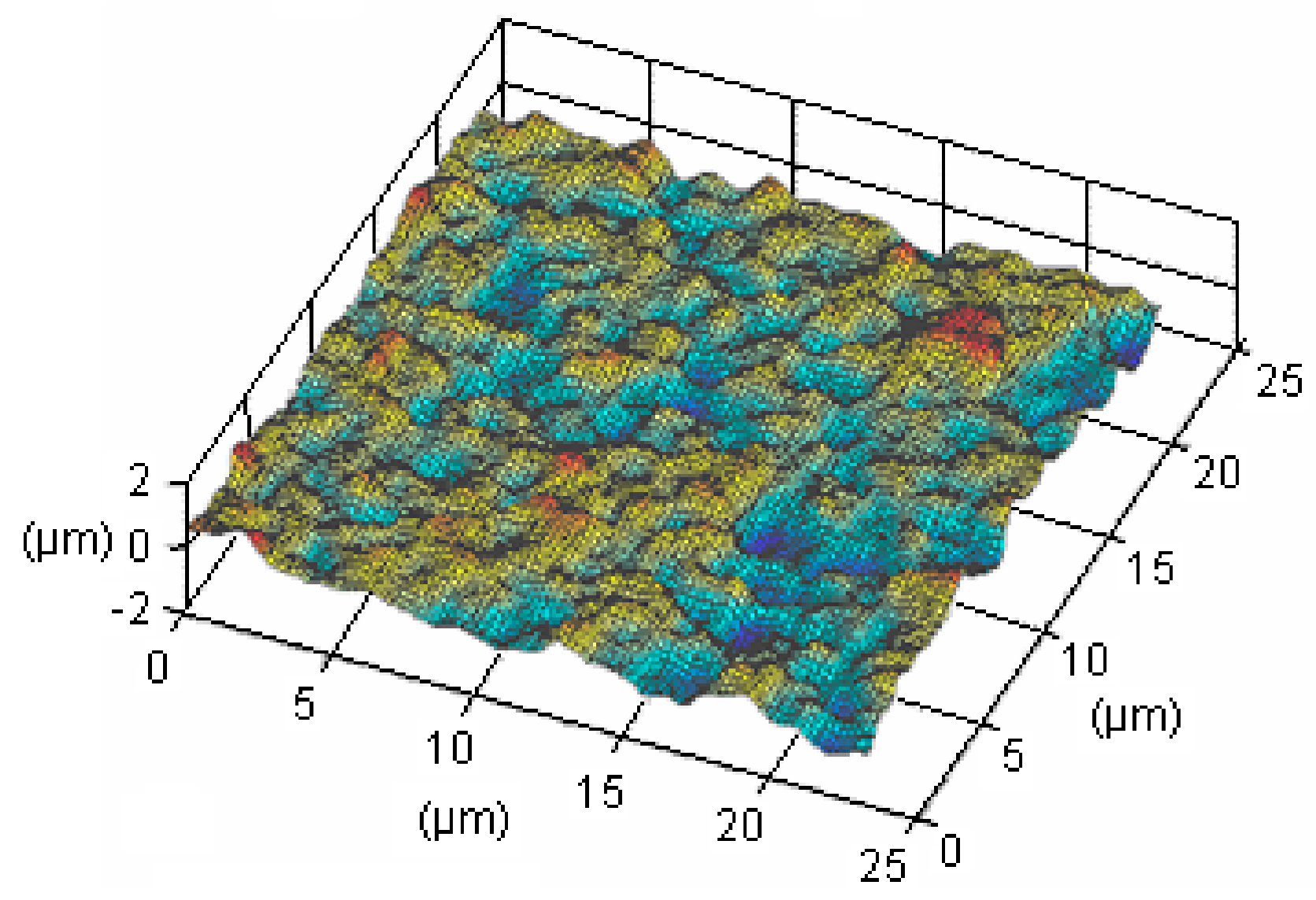
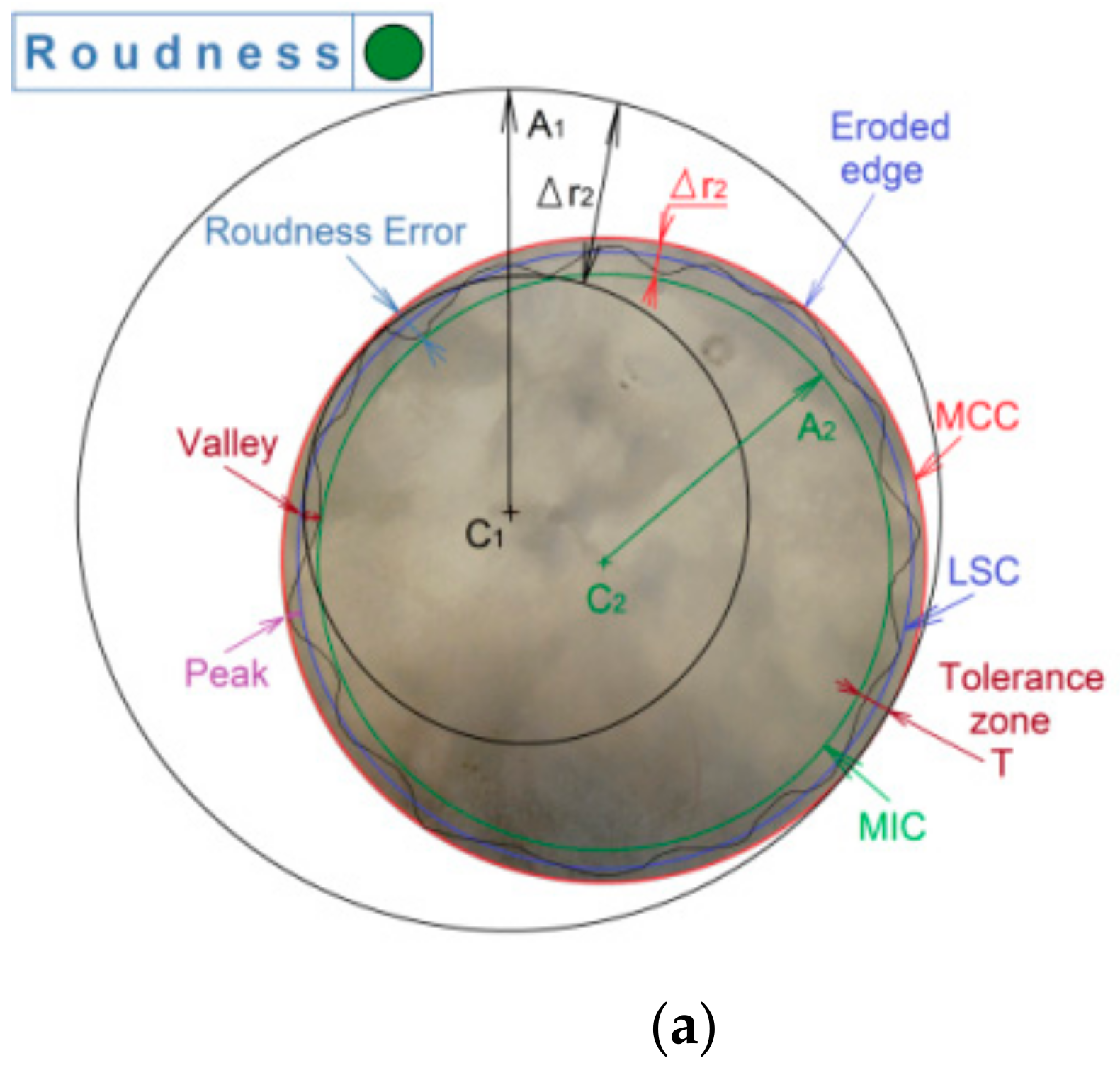


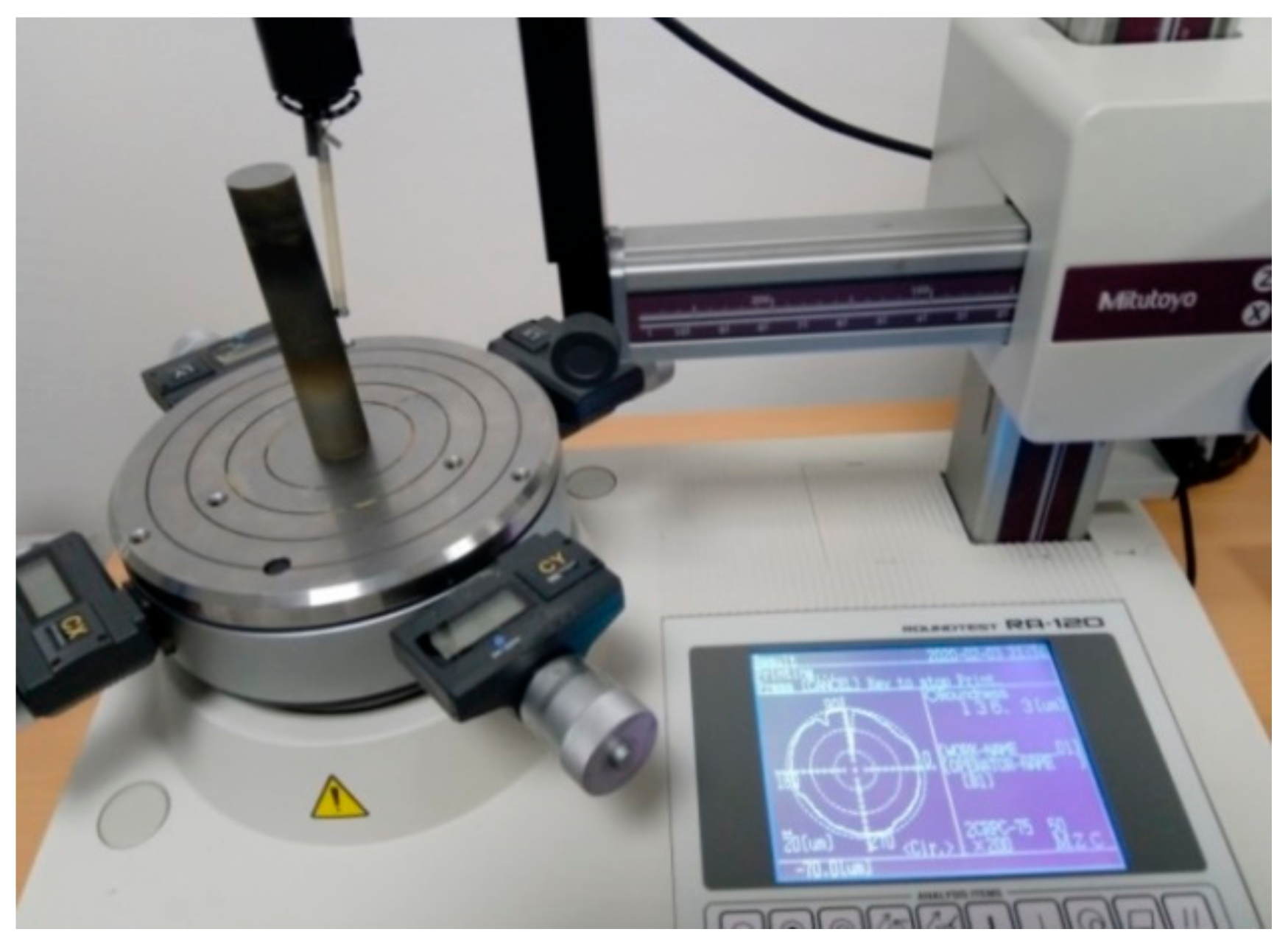
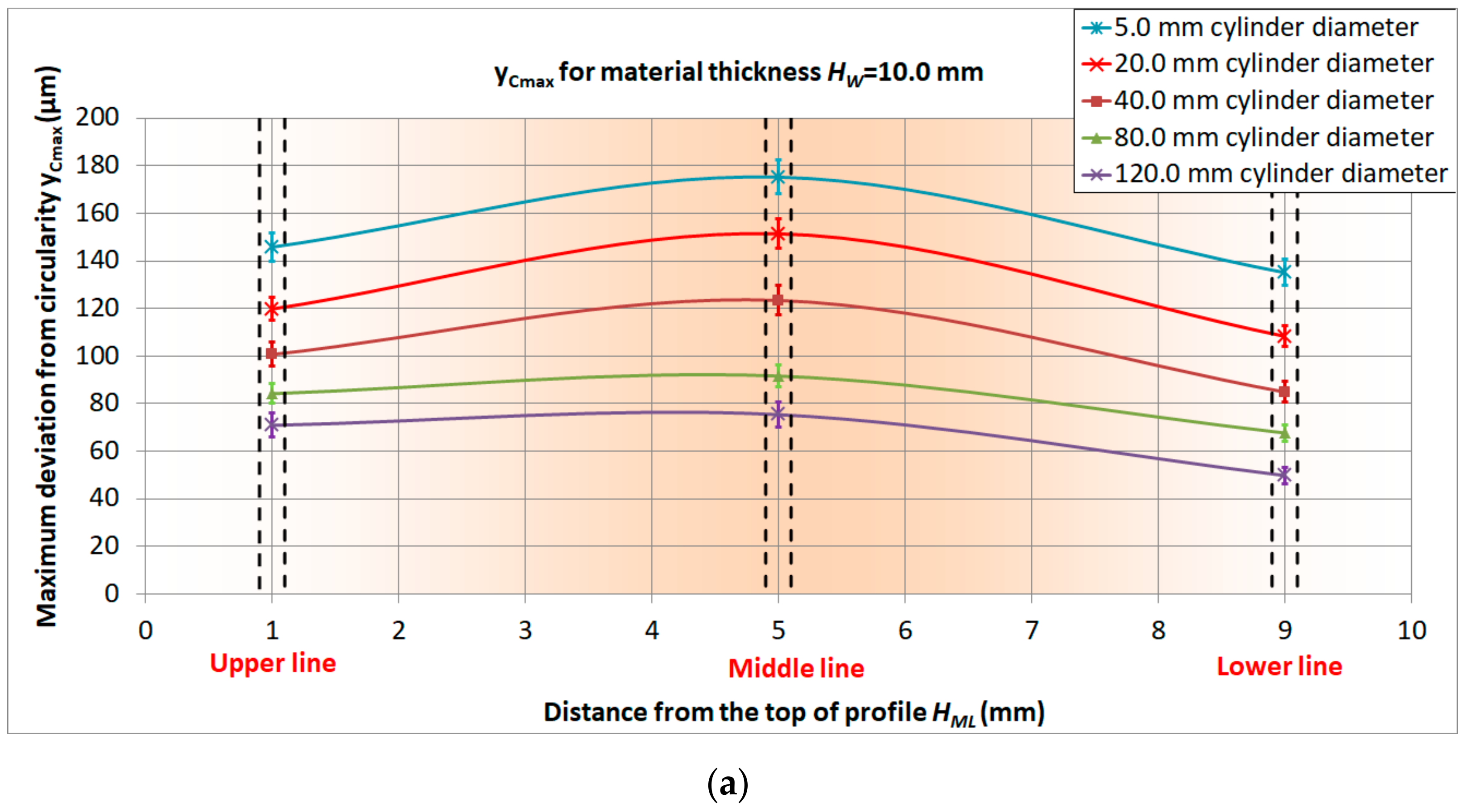
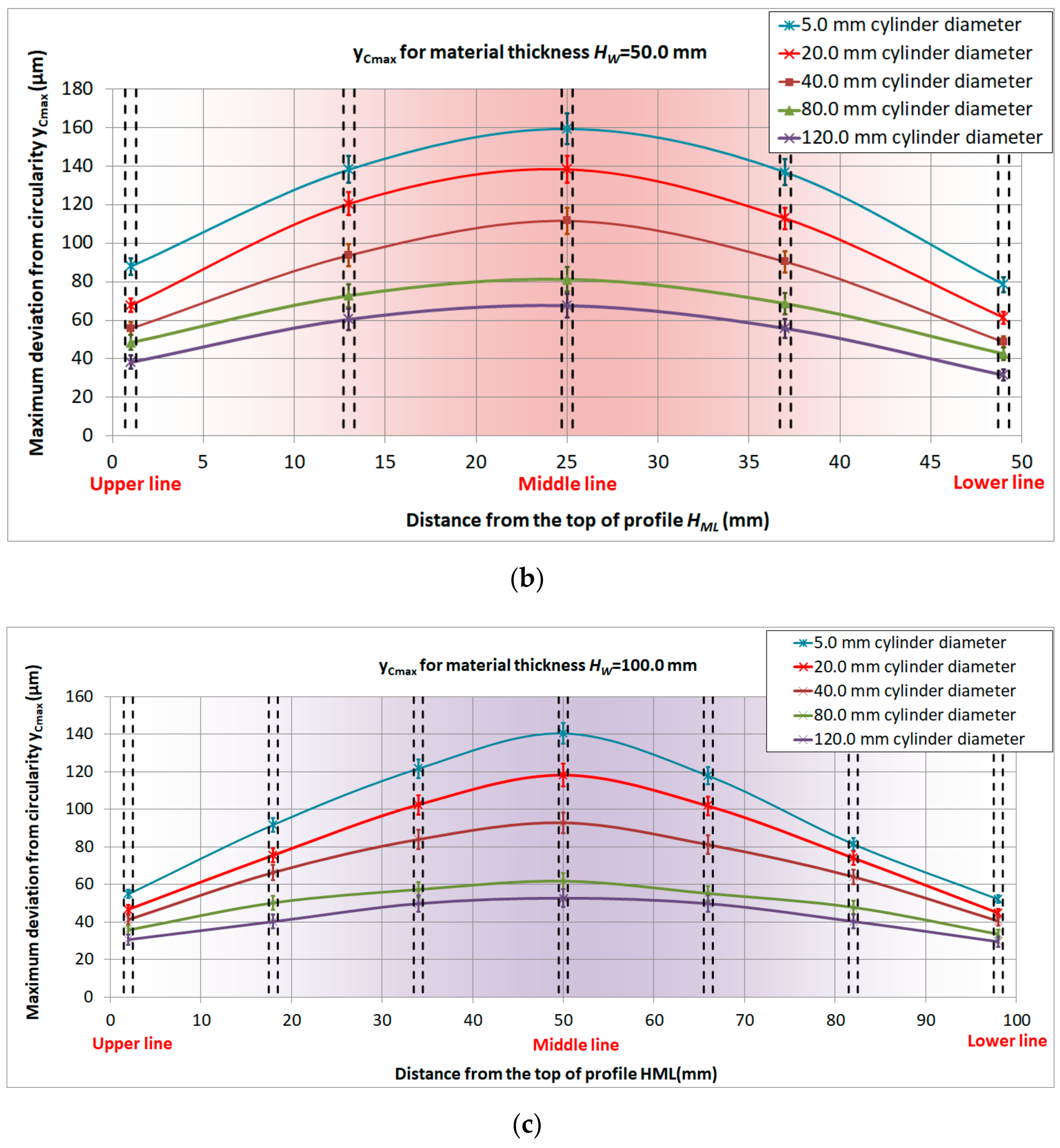

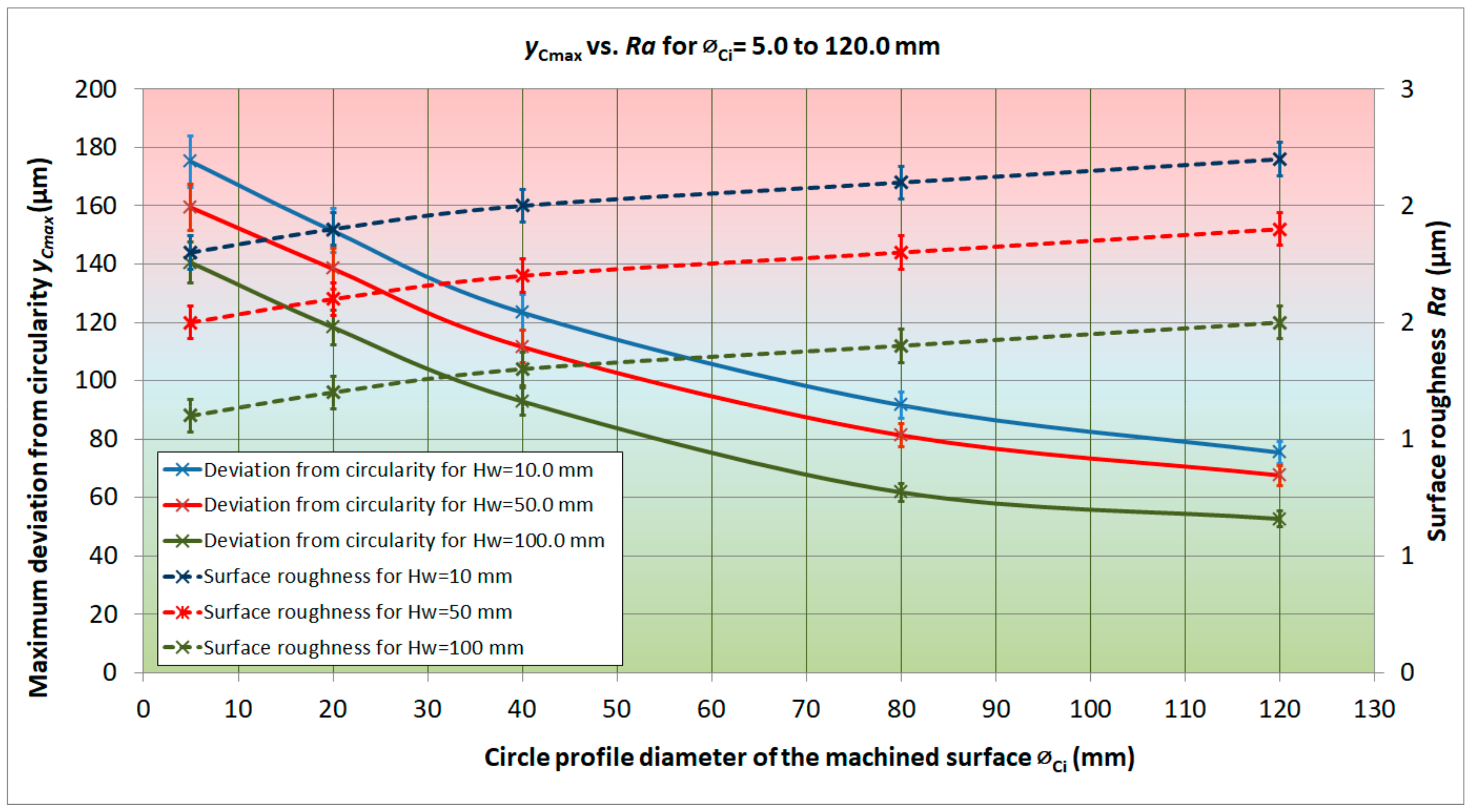
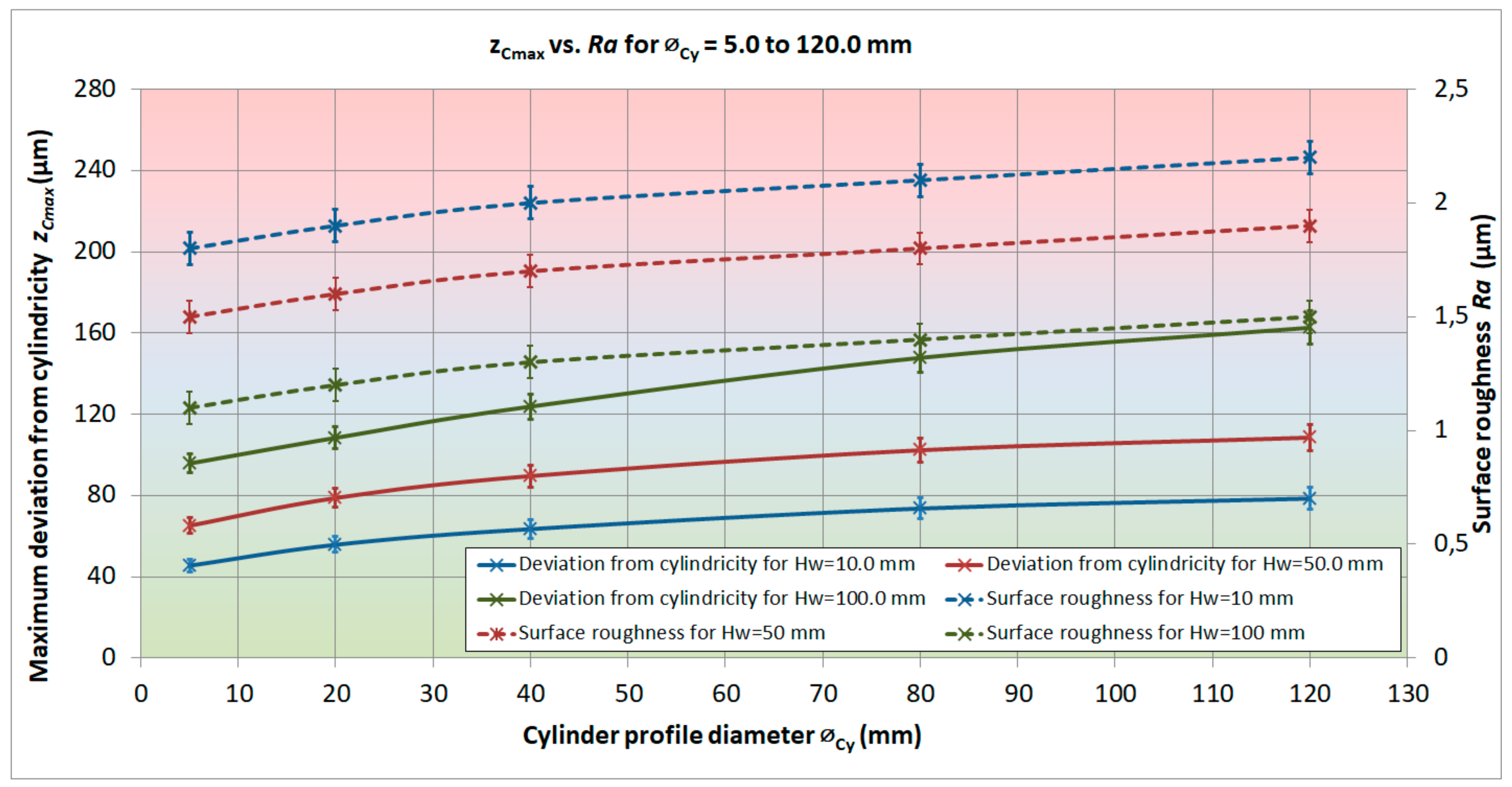
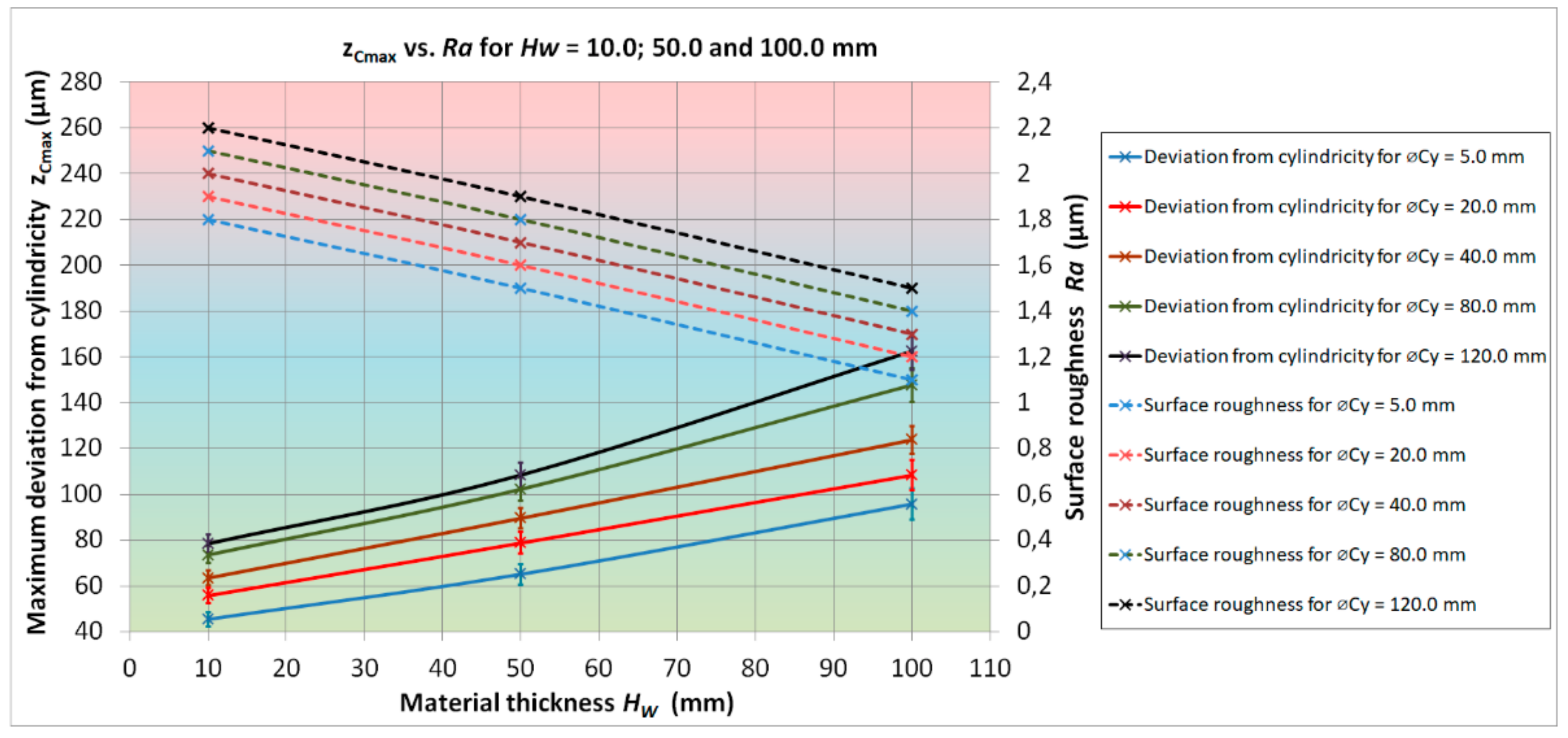


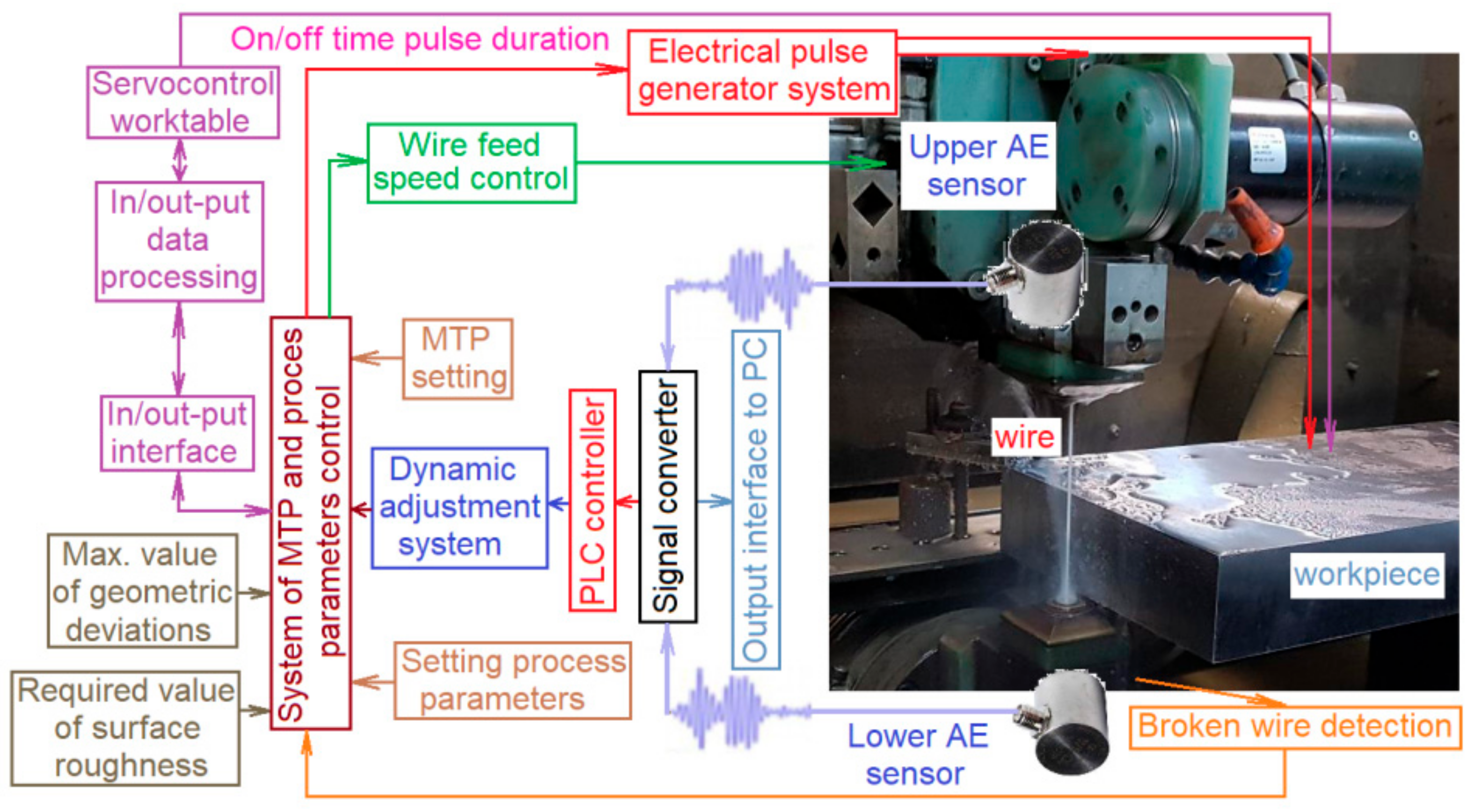
| Main Technological Parameters | Setting Range | Influence of Technological Parameter on Wire Electrode Vibrations |
|---|---|---|
|
Peak current I (A) | 1.0–15.0 | As the value of I increases, the vibrations of the wire electrode increase slightly. |
| Pulse on-time duration ton (μs) | 11.0–19.0 | As the ton value increases, the vibrations of the wire electrode increase significantly. |
| Pulse off-time duration toff (μs) | 15.0–28.0 | As the toff value increases, the vibrations of the wire electrode decrease substantially. |
|
Voltage of discharge U (V) | 65.0–90.0 | As the U value increases, the vibrations of the wire electrode increase slightly. |
| Chemical Composition of Tool Steel EN 40CrMnMoS8-6 (W.-Nr. 1.2312) | ||||||||||
| C | Mn | Si | Cr | Mo | Pmax | Smax | ||||
| 0.35–0.45% | 1.4–1.6% | 0.30–0.50% | 1.8–2.0% | 1.5–0.25% | 0.03% | 0.05–0.1% | ||||
| Selected Mechanical and Physical Properties of Tool Steel EN 40CrMnMoS8-6 (W.-Nr. 1.2312) | ||||||||||
|
Density kg/dm3 | Tensile strength Rm (MPa) (in natural state) | Yield strength Rp0.2 (MPa) (in natural state) | Thermal conductivity W/(m·K) | Specific heat capacity J/(g·K) | Specific electric resist. Ω·mm2/m | Modulus of elesticity E [GPa] | Hardness after quenching HRC | |||
| 7.85 | 960 | 850 | 34.5 | 0.47 | 0.19 | 210 | 50–53 | |||
| Coated Wire Electrode Bedra Megacut pro® TWO/250 | |||||||
|---|---|---|---|---|---|---|---|
| Mechanical properties | Tensile Strength Rm [MPa] | Yield Strength Rp0.2 [MPa] | Proof Stress [MPa] | Hardness HV | Elastic modulus E [GPa] | Elongation A50 [%] | Grain [mm] |
| 900–1000 | ≤500 | 110–500 | ≤170 | 110 | ≥3 | 0.015–0.07 | |
| Physical properties | Electrical conduction [%IACS] | Electrical resistivity [Ω·m] | Melting point [°C] | Thermal conduction λ [W·m−1K−1] | Density ρ [g·cm−3] | specific heat capacity cp 20 °C [J·kg−1K−1] | coefficient of thermal expansion α 20 °C [10−6 K−1] |
| ≥28 | 1.358 | 920 | 116 | 8.45 | 380 | 20.5 | |
| Chemical composition | Cu | Al | Fe | Ni | Pb | Sn | Zn |
| 62–64% | <0.05% | <0.1% | <0.3% | <0.1% | <0.1% | balance | |
Publisher’s Note: MDPI stays neutral with regard to jurisdictional claims in published maps and institutional affiliations. |
© 2021 by the authors. Licensee MDPI, Basel, Switzerland. This article is an open access article distributed under the terms and conditions of the Creative Commons Attribution (CC BY) license (https://creativecommons.org/licenses/by/4.0/).
Share and Cite
Straka, Ľ.; Čorný, I. Adjustment of Wire Vibrations in Order to Improve Geometric Accuracy and Surface Roughness at WEDM. Appl. Sci. 2021, 11, 4734. https://doi.org/10.3390/app11114734
Straka Ľ, Čorný I. Adjustment of Wire Vibrations in Order to Improve Geometric Accuracy and Surface Roughness at WEDM. Applied Sciences. 2021; 11(11):4734. https://doi.org/10.3390/app11114734
Chicago/Turabian StyleStraka, Ľuboslav, and Ivan Čorný. 2021. "Adjustment of Wire Vibrations in Order to Improve Geometric Accuracy and Surface Roughness at WEDM" Applied Sciences 11, no. 11: 4734. https://doi.org/10.3390/app11114734
APA StyleStraka, Ľ., & Čorný, I. (2021). Adjustment of Wire Vibrations in Order to Improve Geometric Accuracy and Surface Roughness at WEDM. Applied Sciences, 11(11), 4734. https://doi.org/10.3390/app11114734






